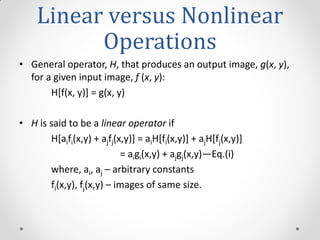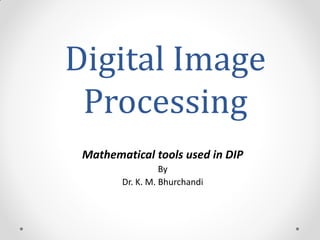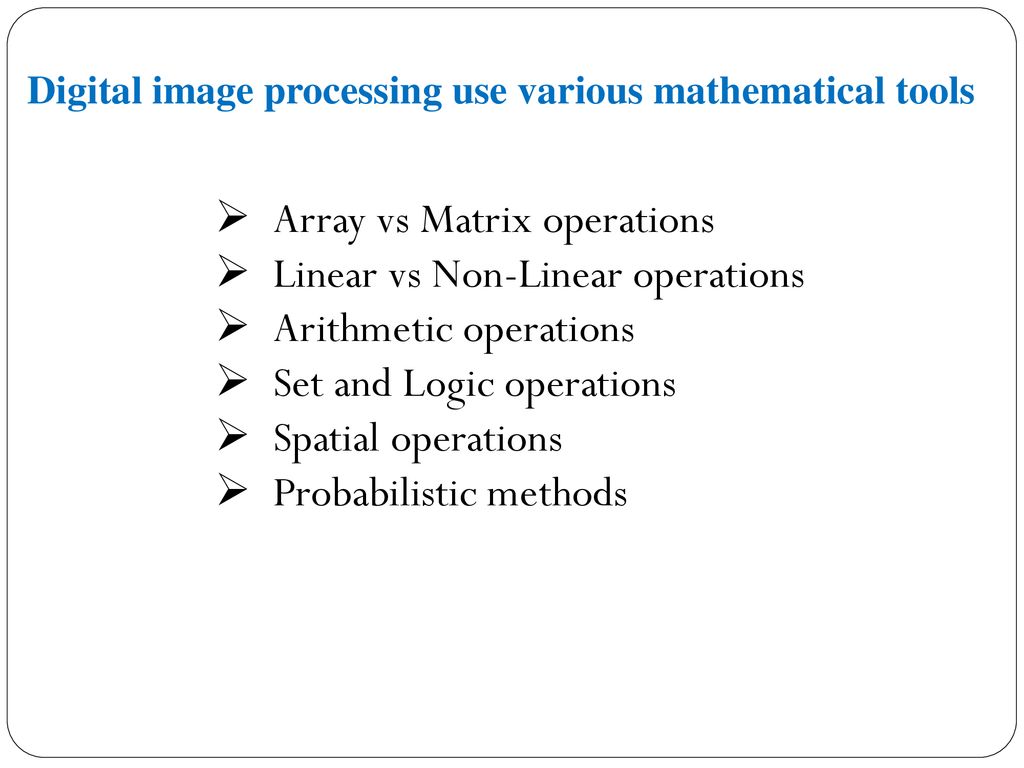Mathematical tools are essential for digital image processing. They help enhance, analyze, and interpret images efficiently.
Digital image processing relies on mathematical tools to manipulate and improve images. Techniques such as Fourier transforms, convolution, and wavelet transforms play a crucial role. These tools facilitate tasks like image enhancement, noise reduction, and feature extraction. Understanding these mathematical concepts is vital for professionals in fields like computer vision, medical imaging, and remote sensing.
Efficient image processing algorithms enhance the clarity and usability of images. This leads to better data interpretation and decision-making. Incorporating these mathematical techniques ensures high-quality image analysis and processing. Therefore, mastering these tools is essential for anyone involved in digital image processing.
Introduction To Digital Image Processing
Digital image processing uses mathematical methods to enhance and analyze images. It converts images into numerical data. This data can be manipulated and improved. The field combines computer science, engineering, and mathematics. This makes it powerful and versatile.
The Role Of Mathematics
Mathematics is the backbone of digital image processing. It helps in transforming images. It also helps in improving image quality. Some key mathematical concepts include:
- Linear Algebra: Used for image transformations and filtering.
- Calculus: Essential for edge detection and image reconstruction.
- Statistics: Helps in noise reduction and image segmentation.
- Fourier Transform: Used for frequency domain analysis.
Real-world Applications
Digital image processing has many real-world applications. Some of the most important include:
- Medical Imaging: Enhances MRI, CT scans, and X-rays for better diagnosis.
- Remote Sensing: Analyzes satellite images for environmental monitoring.
- Facial Recognition: Identifies individuals in security systems.
- Robotics: Helps robots to see and understand their environment.
- Art Restoration: Revives old and damaged artworks.
Mathematical tools make these applications possible. They provide the foundation for image enhancement. They also help in accurate image analysis.
Fundamentals Of Digital Images
Digital images are everywhere today. They are used in photography, medical imaging, and graphic design. Understanding digital images starts with knowing their basic components. This includes pixels, color models, and image formats.
Pixels And Color Models
A digital image is made up of tiny units called pixels. Each pixel represents a color or shade. When you zoom in on a digital image, you can see these individual pixels.
Color models define how colors are represented in an image. The most common color model is RGB. RGB stands for Red, Green, and Blue. These three colors mix to create all other colors. Another popular model is CMYK. CMYK stands for Cyan, Magenta, Yellow, and Key (Black). It is mainly used in printing.
| Color Model | Components | Usage |
|---|---|---|
| RGB | Red, Green, Blue | Digital screens |
| CMYK | Cyan, Magenta, Yellow, Black | Printing |
Image Representation And Formats
Digital images are stored in various formats. Each format has its advantages and disadvantages. Some common formats include JPEG, PNG, and GIF.
- JPEG: Good for photos, uses compression to reduce file size.
- PNG: Supports transparency, lossless compression, good for graphics.
- GIF: Supports animations, limited to 256 colors.
Choosing the right format depends on the image’s use. For high-quality photos, JPEG is often best. For images with transparency, PNG works well. For animations, GIF is the go-to format.
Linear Algebra In Images
Linear algebra is essential in digital image processing. It helps in transforming and analyzing images. This mathematical tool simplifies complex image operations.
Matrices And Image Transformation
Images can be represented using matrices. A matrix is a grid of numbers. Each number represents a pixel’s intensity.
Transforming an image involves matrix operations. Common transformations include rotation, scaling, and translation.
For example, a rotation matrix can turn an image around a point. Here is a simple rotation matrix:
| cos(θ) -sin(θ) |
| sin(θ) cos(θ) |
By multiplying the image matrix with the rotation matrix, the image rotates. This process is fast and efficient.
Eigenvalues And Eigenvectors
Eigenvalues and eigenvectors are crucial in image processing. They help in understanding the structure of images.
Eigenvalues measure the variance in data. They show how much information is in each direction.
Eigenvectors point to the direction of this information. These vectors are perpendicular to each other.
Using eigenvalues and eigenvectors can simplify image compression. Principal Component Analysis (PCA) is one such method. PCA reduces the dimensionality of images.
Here is a step-by-step of PCA:
- Compute the mean of the image data.
- Subtract the mean from each image pixel.
- Calculate the covariance matrix.
- Find the eigenvalues and eigenvectors of the covariance matrix.
- Project the data onto the new basis formed by eigenvectors.
This process keeps the most important features of the image. Thus, reducing the amount of data needed.

Credit: www.youtube.com
Calculus In Image Analysis
Calculus plays a crucial role in digital image processing. It helps in analyzing and transforming images. Calculus provides the mathematical framework for many image processing techniques. This section explores how calculus aids image analysis.
Differential Equations For Image Processing
Differential equations help model changes in image intensity. They are used to describe the relationship between pixel values. This is vital for tasks like image smoothing and noise reduction.
For example, the heat equation smooths images by averaging pixel values:
∂u/∂t = α∇²u
In this equation, u represents the image, t is time, and α is a constant. The term ∇²u is the Laplacian, which measures the rate of change.
Another example is the wave equation used in edge detection:
∂²u/∂t² = c²∇²u
Here, c represents wave speed. These equations help enhance image features and remove noise.
Gradient And Edge Detection
Gradients are essential in identifying edges in images. The gradient of an image measures the rate of change in intensity. It highlights regions with significant changes.
Mathematically, the gradient is represented as:
∇I = [∂I/∂x, ∂I/∂y]
Here, I is the image, and x, y are coordinates. The partial derivatives ∂I/∂x and ∂I/∂y show changes along x and y directions.
Edge detection methods like Sobel and Prewitt use gradients. These methods apply convolution filters to detect edges:
| Filter | Kernel |
|---|---|
| Sobel |
|
| Prewitt |
|
These kernels highlight edges in horizontal and vertical directions. Using gradients helps in extracting important features from images.
Statistics For Image Enhancement
Statistics play a vital role in digital image processing. They help improve the quality of images. Noise reduction and histogram analysis are key techniques in this field. These methods use statistical data to enhance images effectively.
Noise Reduction Techniques
Noise can make an image look bad. Various techniques can reduce this noise. Here are some common methods:
- Mean Filter: This method uses the average value of pixels. It smooths out the image by reducing sharp variations.
- Median Filter: This filter replaces each pixel’s value with the median of its neighbors. It is effective for removing salt-and-pepper noise.
- Gaussian Filter: This uses a Gaussian function to weigh pixels. It helps in reducing Gaussian noise.
These techniques improve image quality significantly. They make images clearer and more visually appealing.
Histogram Analysis
Histograms show the distribution of pixel values in an image. Analyzing histograms can enhance images. Here are key points about histogram analysis:
- Histogram Equalization: This technique spreads out the pixel values. It improves the contrast of the image.
- Histogram Matching: This adjusts the pixel values to match a target histogram. It is used to make one image look like another.
- Thresholding: This separates pixels into two groups. It helps in segmenting objects from the background.
Using histograms helps in making images more informative. It enhances the details and makes them stand out.

Credit: www.slideshare.net
Fourier Transforms And Frequency Domain
Fourier Transforms are essential in digital image processing. They convert images into the frequency domain. This makes it easier to analyze and modify images. By understanding the frequency domain, we can apply powerful image filters and improve image compression.
Understanding Image Filters
Image filters modify an image by emphasizing certain features. Fourier Transforms help in creating these filters. In the frequency domain, filters can target specific frequencies. This allows us to remove noise or sharpen details.
For example, a low-pass filter removes high-frequency noise. A high-pass filter enhances edges by highlighting high frequencies. These filters are applied by manipulating the Fourier Transforms of images. This process is efficient and precise.
Applications In Compression
Fourier Transforms play a key role in image compression. They help reduce the amount of data needed to store images. By focusing on important frequencies, we can discard unnecessary information.
Compression techniques like JPEG use Fourier Transforms. They transform the image into the frequency domain. Then, they compress the data based on frequency importance. This results in smaller file sizes with minimal quality loss.
Here’s a table showcasing the benefits of using Fourier Transforms in compression:
| Benefit | Description |
|---|---|
| Data Reduction | Less data storage needed |
| Quality Maintenance | High quality with smaller size |
| Efficiency | Fast processing and compression |
With Fourier Transforms, image compression becomes more effective. It ensures images remain clear and detailed, even with reduced file sizes.
Wavelets And Multiresolution Analysis
Wavelets and multiresolution analysis are powerful tools in digital image processing. They help in breaking down images into different scales or resolutions. This method provides a more detailed and accurate image analysis. It is widely used in various applications such as image compression, noise reduction, and feature detection.
Scaling Functions
Scaling functions are the building blocks of wavelets. They help in capturing the low-frequency components of an image. Low-frequency components represent the smooth and coarse parts of an image.
Each scaling function is associated with a scale or level. The higher the level, the finer the details captured. This hierarchical structure allows for efficient image representation. Here is a simple table to illustrate this:
| Level | Detail |
|---|---|
| 1 | Coarse |
| 2 | Medium |
| 3 | Fine |
Image Reconstruction
Image reconstruction is the process of building back the image from its wavelet components. This involves combining the low-frequency and high-frequency components. The scaling functions play a crucial role in this process.
Below are the steps for image reconstruction:
- Apply inverse wavelet transform.
- Combine low-frequency and high-frequency components.
- Adjust the levels to get the final image.
The goal is to achieve a lossless reconstruction, maintaining the original image quality.
This method is very effective in various fields, especially in medical imaging and satellite image processing.
Optimization Techniques For Image Restoration
Image restoration improves the appearance of digital images. Optimization techniques play a key role in this process. These techniques help reduce noise and enhance image quality. The use of mathematical tools is essential for efficient image restoration.
Iterative Methods
Iterative methods are powerful for restoring images. They refine the image step by step. Each iteration improves the image quality. One popular method is the Gradient Descent Algorithm.
- It minimizes the difference between the original and restored image.
- It updates the image based on the gradient of the error.
Another effective method is the Conjugate Gradient Method. It is faster than gradient descent. It uses previous iterations to guide the next step.
| Method | Speed | Accuracy |
|---|---|---|
| Gradient Descent | Medium | High |
| Conjugate Gradient | Fast | High |
Regularization Strategies
Regularization strategies are crucial for image restoration. They control the complexity of the restoration process. One common technique is Tikhonov Regularization.
This method adds a penalty term to the optimization problem. It balances between fitting the data and smoothing the image. Another strategy is Total Variation Regularization.
- It preserves edges while reducing noise.
- It is effective for images with sharp transitions.
Both methods enhance the quality of restored images. They prevent overfitting and improve generalization.
Machine Learning For Image Processing
Machine learning is revolutionizing digital image processing. It enables machines to recognize patterns and make decisions. This is crucial for various applications, from medical imaging to self-driving cars.
Feature Extraction
Feature extraction is a critical step in image processing. It simplifies the image data by reducing the amount of information. This process makes it easier for machines to understand and analyze images.
Features can be edges, textures, or specific shapes. These features help in identifying objects within an image. Here’s a table summarizing common feature extraction techniques:
| Technique | Description |
|---|---|
| Edge Detection | Identifies boundaries within an image. |
| Texture Analysis | Examines surface patterns and textures. |
| Shape Recognition | Detects specific shapes like circles or squares. |
Feature extraction is essential for training machine learning models. It reduces the complexity of data and focuses on relevant information.
Deep Learning Models
Deep learning models are a subset of machine learning. They use neural networks to process data. These models are highly effective in image processing.
Convolutional Neural Networks (CNNs) are popular deep learning models. They excel at image recognition tasks. CNNs use layers to detect various features. This makes them powerful tools for image classification.
Here are some key components of CNNs:
- Convolutional Layer: Extracts features from the input image.
- Pooling Layer: Reduces the dimensionality of the data.
- Fully Connected Layer: Connects all neurons from the previous layer.
Deep learning models require large datasets for training. They also need substantial computational power. Yet, their accuracy in image processing is unmatched.
Software And Tools For Image Processing
Digital image processing relies on advanced software and tools. They help manipulate and enhance images. Various programming languages, libraries, and frameworks assist in this field. This section explores the most popular tools used by professionals and enthusiasts alike.
Popular Programming Languages
Several programming languages are useful for image processing tasks. Each has its own strengths and community support. Here are some of the most popular ones:
- Python: Known for its simplicity and readability. Popular for its extensive libraries.
- MATLAB: Offers powerful tools and functions for image analysis.
- C++: Provides high performance and control over low-level operations.
- Java: Known for its cross-platform capabilities and robust libraries.
Libraries And Frameworks
Libraries and frameworks simplify complex image processing tasks. They offer pre-built functions and tools. Below is a table of some widely used libraries and frameworks:
| Library/Framework | Description | Language |
|---|---|---|
| OpenCV | Open-source library for computer vision and machine learning. | Python, C++, Java |
| scikit-image | Collection of algorithms for image processing. | Python |
| PIL/Pillow | Python Imaging Library for opening, manipulating, and saving images. | Python |
| SimpleCV | An open-source framework for building computer vision applications. | Python |
| ImageJ | Java-based software for image analysis. | Java |
Practice And Skill Enhancement
Enhancing your skills in digital image processing requires consistent practice. Engaging in hands-on projects and challenges sharpens your expertise. Enrolling in courses and earning certifications also boosts your knowledge and credibility.
Projects And Challenges
Working on real-world projects helps you understand practical applications. Here are some project ideas:
- Image filtering and enhancement
- Edge detection using different algorithms
- Object recognition and classification
- Image segmentation and clustering
- Image compression techniques
Participating in challenges can also enhance your skills. Consider these popular platforms:
| Platform | Description |
|---|---|
| Kaggle | Hosts competitions for image processing tasks |
| GitHub | Find and contribute to open-source projects |
| Codewars | Offers coding challenges to sharpen your skills |
Courses And Certifications
Enrolling in courses provides structured learning. Certifications validate your skills. Here are some recommended courses and certifications:
- Coursera: Image Processing courses by top universities
- edX: Offers professional certifications
- Udacity: Nanodegree programs in AI and image processing
- Udemy: Wide range of beginner to advanced courses
Obtaining certifications can significantly boost your career. Consider these options:
- Certified Image Processing Professional (CIPP)
- Microsoft Certified: Azure AI Engineer Associate
- Google Professional Machine Learning Engineer
By working on projects, participating in challenges, and earning certifications, you can enhance your skills and expertise in digital image processing.

Credit: www.slideshare.net
Frequently Asked Questions
What Are The Mathematical Tools Used In Digital Image Processing?
Mathematical tools in digital image processing include Fourier Transform, Wavelet Transform, convolution, filtering, and statistical methods. These tools enhance, analyze, and compress images efficiently.
How Does Mathematics Contribute To Image Processing?
Mathematics enhances image processing through algorithms, transforms, and models. It improves image quality, compression, and recognition. Techniques like Fourier transforms and linear algebra are crucial.
How Can A Digital Image Be Represented By A Mathematical Expression?
A digital image can be represented by a matrix of pixel values. Each pixel value corresponds to a color or intensity.
How Is Calculus Used In Image Processing?
Calculus in image processing helps analyze and enhance images. It detects edges, optimizes filters, and improves resolution. Calculus also aids in image transformation, segmentation, and reconstruction tasks.
Conclusion
Mastering mathematical tools is crucial for effective digital image processing. These techniques enhance image clarity and analysis. By understanding and applying these tools, you can significantly improve image quality. Stay updated with the latest advancements to ensure optimal results. Dive into the world of digital image processing and transform your projects.



